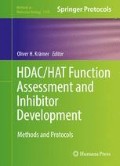Abstract
Histone deacetylases (HDACs) catalyze the deacetylation of lysine residues in their target proteins. This biochemical modification can have profound effects on the functions of these proteins and a dysregulation of HDAC activity contributes to severe diseases, including neoplastic transformation. In the following chapter, we present a strategy that allows to distinguish between the inhibition of the class I HDACs HDAC1, 2, and 3 and of the class IIb HDAC HDAC6. This method is based on Western blot and relies on the detection of hyperacetylated substrates of class I or class IIb HDACs in lysates from cells that were treated with histone deacetylase inhibitors (HDACi).
Access this chapter
Tax calculation will be finalised at checkout
Purchases are for personal use only
References
Spange S, Wagner T, Heinzel T, Krämer OH (2009) Acetylation of non-histone proteins modulates cellular signalling at multiple levels. Int J Biochem Cell Biol 41:185–198
Villagra A, Sotomayor EM, Seto E (2009) Histone deacetylases and the immunological network: implications in cancer and inflammation. Oncogene 29:157–173
Buchwald M, Krämer OH, Heinzel T (2009) HDACi—targets beyond chromatin. Cancer Lett 280:160–167
Krämer OH (2009) HDAC2: a critical factor in health and disease. Trends Pharmacol Sci 30:647–655
Halkidou K, Gaughan L, Cook S, Leung HY, Neal DE, Robson CN (2004) Upregulation and nuclear recruitment of HDAC1 in hormone refractory prostate cancer. Prostate 59:177–189
Wilson AJ, Byun DS, Popova N, Murray LB, L’Italien K, Sowa Y, Arango D, Velcich A, Augenlicht LH, Mariadason JM (2006) Histone deacetylase 3 (HDAC3) and other class I HDACs regulate colon cell maturation and p21 expression and are deregulated in human colon cancer. J Biol Chem 281:13548–13558
Lee SH, Yoo C, Im S, Jung JH, Choi HJ, Yoo J (2014) Expression of histone deacetylases in diffuse large B-cell lymphoma and its clinical significance. Int J Med Sci 11:994–1000
Zhang Z, Yamashita H, Toyama T, Sugiura H, Ando Y, Mita K, Hamaguchi M, Hara Y, Kobayashi S, Iwase H (2005) Quantitation of HDAC1 mRNA expression in invasive carcinoma of the breast. Breast Cancer Res Treat 94:11–16
Zhu P, Martin E, Mengwasser J, Schlag P, Janssen KP, Göttlicher M (2004) Induction of HDAC2 expression upon loss of APC in colorectal tumorigenesis. Cancer Cell 5:455–463
Zhang Z, Yamashita H, Toyama T, Sugiura H, Omoto Y, Ando Y, Mita K, Hamaguchi M, Hayashi S, Iwase H (2004) HDAC6 expression is correlated with better survival in breast cancer. Clin Cancer Res 10:6962–6968
Falkenberg KJ, Johnstone RW (2014) Histone deacetylases and their inhibitors in cancer, neurological diseases and immune disorders. Nat Rev Drug Discov 13:673–691
Bolden JE, Peart MJ, Johnstone RW (2006) Anticancer activities of histone deacetylase inhibitors. Nat Rev Drug Discov 5:769–784
Parmigiani RB, Xu WS, Venta-Perez G, Erdjument-Bromage H, Yaneva M, Tempst P, Marks PA (2008) HDAC6 is a specific deacetylase of peroxiredoxins and is involved in redox regulation. Proc Natl Acad Sci U S A 105:9633–9638
Krämer OH, Mahboobi S, Sellmer A (2014) Drugging the HDAC6-HSP90 interplay in malignant cells. Trends Pharmacol Sci 35:501–509
Bradner JE, Mak R, Tanguturi SK, Mazitschek R, Haggarty SJ, Ross K, Chang CY, Bosco J, West N, Morse E, Lin K, Shen JP, Kwiatkowski NP, Gheldof N, Dekker J, DeAngelo DJ, Carr SA, Schreiber SL, Golub TR, Ebert BL (2010) Chemical genetic strategy identifies histone deacetylase 1 (HDAC1) and HDAC2 as therapeutic targets in sickle cell disease. Proc Natl Acad Sci U S A 107:12617–12622
Göttlicher M, Minucci S, Zhu P, Krämer OH, Schimpf A, Giavara S, Sleeman JP, Lo Coco F, Nervi C, Pelicci PG, Heinzel T (2001) Valproic acid defines a novel class of HDAC inhibitors inducing differentiation of transformed cells. EMBO J 20:6969–6978
Bhalla KN (2005) Epigenetic and chromatin modifiers as targeted therapy of hematologic malignancies. J Clin Oncol 23:3971–3993
Hu E, Dul E, Sung CM, Chen Z, Kirkpatrick R, Zhang GF, Johanson K, Liu R, Lago A, Hofmann G, Macarron R, de los Frailes M, Perez P, Krawiec J, Winkler J, Jaye M (2003) Identification of novel isoform-selective inhibitors within class I histone deacetylases. J Pharmacol Exp Ther 307:720–728
Maiso P, Carvajal-Vergara X, Ocio EM, Lopez-Perez R, Mateo G, Gutierrez N, Atadja P, Pandiella A, San Miguel JF (2006) The histone deacetylase inhibitor LBH589 is a potent antimyeloma agent that overcomes drug resistance. Cancer Res 66:5781–5789
Brandl A, Heinzel T, Krämer OH (2009) Histone deacetylases: salesmen and customers in the post-translational modification market. Biol Cell 101:193–205
Acknowledgment
This work was supported by grants to OHK from the Wilhelm Sander foundation (#2010.078) and the Deutsche Forschungsgemeinschaft (#KR22 91/4–1).
Author information
Authors and Affiliations
Corresponding author
Editor information
Editors and Affiliations
Rights and permissions
Copyright information
© 2017 Springer Science+Business Media New York
About this protocol
Cite this protocol
Beyer, M., Kiweler, N., Mahboobi, S., Krämer, O.H. (2017). How to Distinguish Between the Activity of HDAC1-3 and HDAC6 with Western Blot. In: Krämer, O. (eds) HDAC/HAT Function Assessment and Inhibitor Development. Methods in Molecular Biology, vol 1510. Humana Press, New York, NY. https://doi.org/10.1007/978-1-4939-6527-4_26
Download citation
DOI: https://doi.org/10.1007/978-1-4939-6527-4_26
Published:
Publisher Name: Humana Press, New York, NY
Print ISBN: 978-1-4939-6525-0
Online ISBN: 978-1-4939-6527-4
eBook Packages: Springer Protocols

